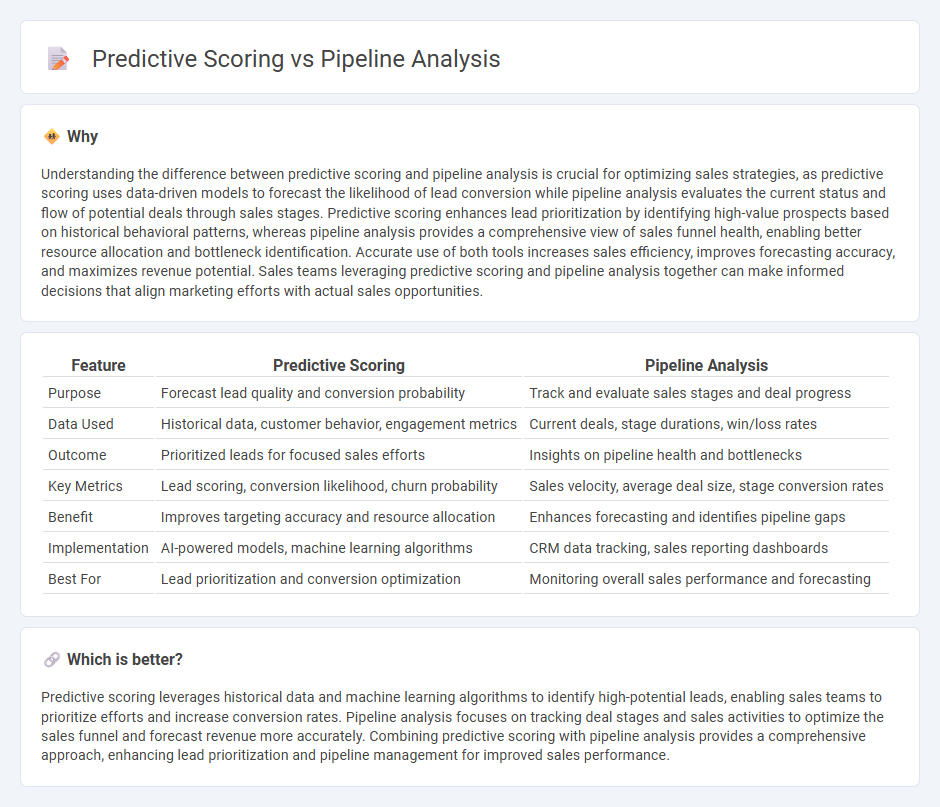
Predictive scoring uses historical data and machine learning algorithms to forecast the likelihood of leads converting into customers, enabling sales teams to prioritize high-potential prospects effectively. Pipeline analysis focuses on evaluating the current sales funnel stages, identifying bottlenecks, and assessing the health of ongoing deals to improve forecasting accuracy and resource allocation. Explore deeper insights into how predictive scoring and pipeline analysis can revolutionize your sales strategy.
Why it is important
Understanding the difference between predictive scoring and pipeline analysis is crucial for optimizing sales strategies, as predictive scoring uses data-driven models to forecast the likelihood of lead conversion while pipeline analysis evaluates the current status and flow of potential deals through sales stages. Predictive scoring enhances lead prioritization by identifying high-value prospects based on historical behavioral patterns, whereas pipeline analysis provides a comprehensive view of sales funnel health, enabling better resource allocation and bottleneck identification. Accurate use of both tools increases sales efficiency, improves forecasting accuracy, and maximizes revenue potential. Sales teams leveraging predictive scoring and pipeline analysis together can make informed decisions that align marketing efforts with actual sales opportunities.
Comparison Table
| Feature | Predictive Scoring | Pipeline Analysis |
|---|---|---|
| Purpose | Forecast lead quality and conversion probability | Track and evaluate sales stages and deal progress |
| Data Used | Historical data, customer behavior, engagement metrics | Current deals, stage durations, win/loss rates |
| Outcome | Prioritized leads for focused sales efforts | Insights on pipeline health and bottlenecks |
| Key Metrics | Lead scoring, conversion likelihood, churn probability | Sales velocity, average deal size, stage conversion rates |
| Benefit | Improves targeting accuracy and resource allocation | Enhances forecasting and identifies pipeline gaps |
| Implementation | AI-powered models, machine learning algorithms | CRM data tracking, sales reporting dashboards |
| Best For | Lead prioritization and conversion optimization | Monitoring overall sales performance and forecasting |
Which is better?
Predictive scoring leverages historical data and machine learning algorithms to identify high-potential leads, enabling sales teams to prioritize efforts and increase conversion rates. Pipeline analysis focuses on tracking deal stages and sales activities to optimize the sales funnel and forecast revenue more accurately. Combining predictive scoring with pipeline analysis provides a comprehensive approach, enhancing lead prioritization and pipeline management for improved sales performance.
Connection
Predictive scoring enhances sales effectiveness by assigning data-driven likelihoods for lead conversion, enabling sales teams to focus on high-potential prospects. Pipeline analysis leverages these scores to identify bottlenecks and forecast revenue with greater accuracy. Integrating predictive scoring with pipeline analysis optimizes decision-making and resource allocation throughout the sales cycle.
Key Terms
**Pipeline Analysis:**
Pipeline analysis evaluates each stage of the sales funnel to identify bottlenecks and optimize conversion rates, leveraging CRM data and historical sales trends. It provides granular insights into deal progression, helping sales teams allocate resources effectively and forecast revenue more accurately. Discover how pipeline analysis can transform your sales strategy for improved performance.
Deal Stages
Pipeline analysis evaluates the progression of opportunities across defined Deal Stages to identify bottlenecks and forecast revenue based on current sales activities. Predictive scoring uses historical data and machine learning algorithms to assign a likelihood score to each deal stage, enhancing prioritization and resource allocation. Explore detailed comparisons to optimize your sales strategy and improve closure rates.
Conversion Rate
Pipeline analysis tracks the stages of sales funnel progression to identify bottlenecks and optimize deal closures, directly impacting conversion rates by revealing drop-off points. Predictive scoring uses historical data and machine learning models to assign scores to leads, prioritizing those most likely to convert and improving the efficiency of sales efforts. Explore detailed methodologies and tools to enhance conversion rates through pipeline analysis and predictive scoring techniques.
Source and External Links
Drug Pipeline Analysis - Umbrex - Pipeline analysis in pharmaceuticals involves assessing a company's drug development pipeline by gathering data on drug phases, calculating success likelihoods, estimating market potential, performing risk and timeline assessments, and evaluating partnerships to understand strength and risks of the portfolio.
What is Pipeline Analysis? - DealHub - Sales pipeline analysis reviews how deals progress through stages by defining sales steps, tracking deals in real-time via CRM, measuring metrics like conversion rates and sales velocity, identifying gaps where deals stall, and adjusting sales strategies accordingly to improve pipeline efficiency.
Sales Pipeline Analysis: Best Tips & Practices - Revenue Grid - This analysis tracks key sales metrics such as number and value of opportunities, win and conversion rates, average deal size and sales cycle length, to identify points where leads drop off and optimize the sales process with accurate data and potentially AI-powered tools.
 dowidth.com
dowidth.com